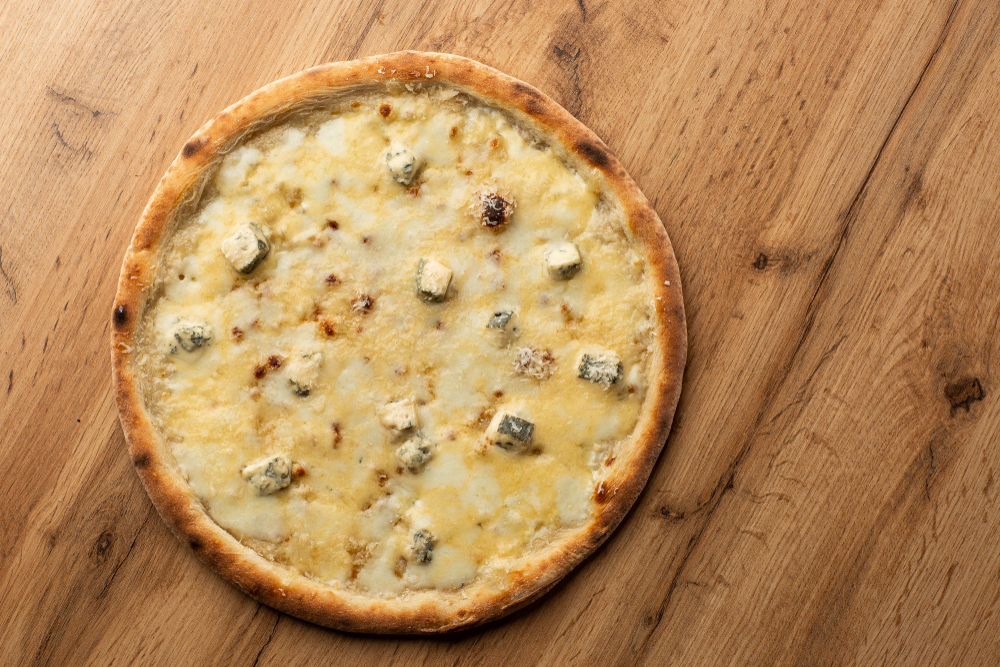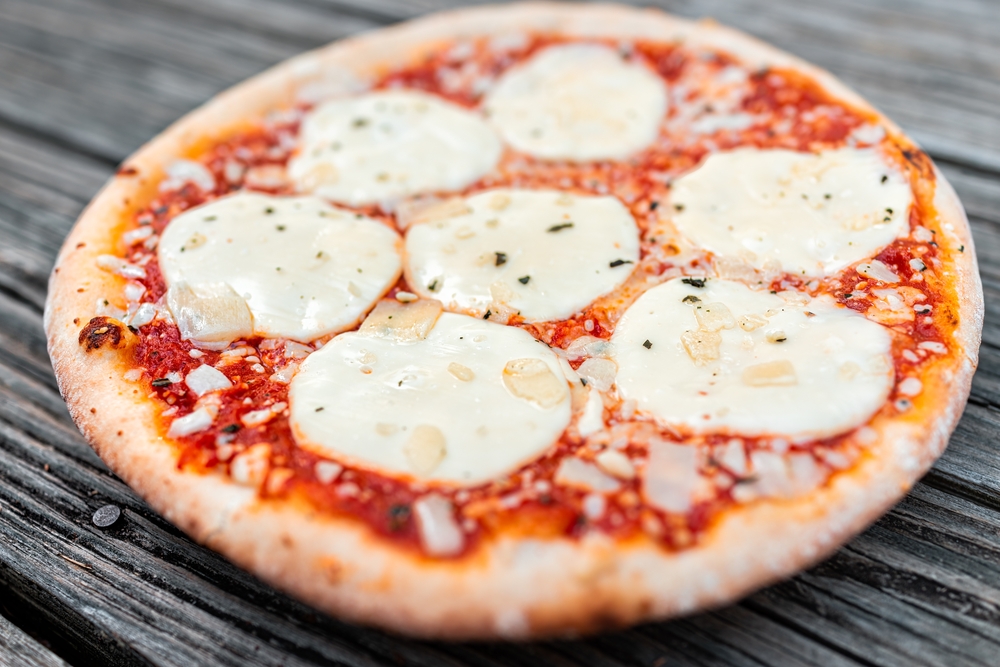Choosing the appropriate cheese is crucial for creating the ideal pizza. Even while mozzarella is the most popular cheese for pizza, there are other alternatives that can give your pie extra taste and texture. Fontina, an Italian semi-soft cheese, is one example of this.

The flavor of fontina cheese is rich, nutty, and somewhat sweet. It melts beautifully, which makes it a great option for pizza.
It is very adaptable and may be mixed with various cheeses to create a distinctive flavor profile, including mozzarella, parmesan, and gorgonzola. Fontina cheese is produced from cow’s milk and has a light yellow tint with numerous microscopic holes.
Its creamy, silky texture makes it simple to spread on pizza dough. Overall, fontina cheese is a great option for pizza lovers trying to up their game.
What is Fontina Cheese?
Fontina cheese is a semi-soft cheese that originated in Italy. It is traditionally made from unpasteurized cow’s milk from cows in the Aosta Valley, an Alpine region in northwest Italy.
Fontina cheese is also made in Denmark, Sweden, the United States, Canada, and Argentina.
Origins and Characteristics
Fontina cheese has a mild, nutty flavor that pairs well with pizza. It is a semi-soft cheese, so it melts easily and helps create a gooey, cheesy pizza.
The milk fat content of Fontina cheese is around 45%, resulting in a rich and creamy texture and a nutty, buttery flavor that gets sharper with age.
The cheese is typically aged for 90 days in caverns that give the cheese its unique and nuanced flavor. Aged Fontina cheese has a stronger, more pungent flavor than fresh Fontina cheese.
Aged vs. Fresh Fontina Cheese
Aged Fontina cheese has a more complex flavor than fresh Fontina cheese. It is sharper and more pungent, with a nutty, buttery flavor that becomes more pronounced as it ages.
Fresh Fontina cheese, on the other hand, has a milder, creamier flavor. It is less sharp than aged Fontina cheese, with a nutty, buttery flavor that is still present but less pronounced.
When it comes to using Fontina cheese on pizza, both aged and fresh Fontina cheese can be used. Aged Fontina cheese pairs well with bold, flavorful toppings like spicy sausage or pepperoni, while fresh Fontina cheese is a great choice for pizzas with lighter toppings like mushrooms or arugula.
Fontina cheese is a versatile and flavorful cheese that is perfect for pizza. Whether you prefer aged or fresh Fontina cheese, it is sure to add a delicious and unique flavor to your pizza.
Why Use Fontina Cheese for Pizza?
When it comes to pizza, the cheese is an essential ingredient that can make or break the flavor and texture of the dish. While mozzarella is the most commonly used cheese for pizza, there are other options that can add a unique touch to your pizza, and one of them is fontina cheese.

Flavor Profile
Fontina cheese has a mild and nutty flavor with a hint of sharpness that makes it perfect for pizza. It has a unique taste that sets it apart from other cheeses like cheddar, provolone, and gouda.
The flavor of fontina cheese pairs well with a variety of toppings, including sausage, mushrooms, and roasted peppers. It also goes well with other cheeses like goat cheese, which adds a tangy flavor to the pizza.
Texture
Fontina cheese has a semi-soft texture that melts easily, making it perfect for pizza. It creates a gooey and stretchy layer of cheese that covers the pizza, making each bite delicious and satisfying.
The texture of fontina cheese is also perfect for blending with other cheeses, creating a unique and complex flavor profile.
Melting Properties
One of the best things about fontina cheese is its melting properties. It melts quickly and evenly, creating a smooth and creamy layer of cheese on top of the pizza crust.
Unlike other cheeses that can become oily or greasy when melted, fontina cheese retains its texture and flavor, making it perfect for pizza.
Fontina cheese is a delicious and unique cheese that can elevate the flavor and texture of your pizza. Its mild and nutty flavor, semi-soft texture, and excellent melting properties make it a great addition to any pizza recipe.
So, next time you’re making pizza, consider using fontina cheese to create a delicious and unforgettable dish.
How to Use Fontina Cheese for Pizza
When it comes to making pizza, cheese is one of the most important ingredients. Fontina cheese is a delicious option that can add a unique flavor and texture to your pizza.

In this section, we will discuss how to use fontina cheese for pizza, including pairing it with other cheeses, toppings and seasonings, and baking tips.
Pairing with Other Cheeses
Fontina cheese pairs well with a variety of other cheeses, including Parmesan, mozzarella, and Gouda.
Combining fontina with other cheeses can help balance out its flavor and texture. For example, you can mix fontina with Parmesan cheese to add a nutty, salty flavor to your pizza.
Toppings and Seasonings
Fontina cheese can be paired with a variety of toppings and seasonings to create a delicious pizza. Some popular options include caramelized onions, thyme, mushrooms, and garlic.
When using fontina cheese, it’s important to keep in mind that it has a mild flavor, so you may want to pair it with bold toppings and seasonings to create a more complex flavor profile.
Baking Tips
When baking pizza with fontina cheese, there are a few tips to keep in mind. First, be sure to evenly distribute the cheese on the pizza to ensure that it melts evenly.
Second, preheat your oven to a high temperature (around 450-500°F) to ensure that the cheese gets bubbly and golden brown. Finally, consider brushing the crust with olive oil and sprinkling it with salt to add flavor and help it crisp up.
Fontina cheese is a delicious option for pizza that can add a unique flavor and texture to your pie.
By pairing it with other cheeses, bold toppings and seasonings, and following these baking tips, you can create a delicious pizza that everyone will love.
Nutrition Facts and Health Benefits
When it comes to pizza toppings, fontina cheese is a popular choice due to its rich and nutty flavor. But how does it stack up nutritionally? Let’s take a closer look at the nutrition facts and health benefits of fontina cheese.

Calories and Macronutrients
One cup of diced fontina cheese contains approximately 513 calories. It is a good source of protein, with 33.79g per serving.
However, it is also high in fat, with 41.1g of total fat and 25.339g of saturated fat. It is important to consume fontina cheese in moderation to avoid exceeding daily recommended fat intake.
Micronutrients
Fontina cheese is a good source of calcium, providing 726mg per serving. Calcium is essential for healthy bones and teeth, and also plays a role in muscle function and nerve communication.
Fontina cheese also contains iron, which is important for healthy blood cells and energy production.
Sodium and Fat Content
One serving of fontina cheese contains 1056mg of sodium, which is high compared to other cheeses. High sodium intake has been linked to increased risk of high blood pressure and heart disease, so it is important to limit consumption of high-sodium foods.
Fontina cheese is also high in fat, particularly saturated fat, which can contribute to high cholesterol levels and increased risk of heart disease.
While fontina cheese can be a tasty addition to pizza, it should be consumed in moderation due to its high calorie, fat, and sodium content.
However, it does provide some important micronutrients such as calcium and iron. As with any food, it is important to consider portion size and overall dietary intake when incorporating fontina cheese into your diet.
Other Uses for Fontina Cheese
Fontina cheese is not only great for pizza but also has other delicious uses. Here are some of our favorite ways to use fontina cheese:

Casseroles and Mac and Cheese
Fontina cheese is perfect for casseroles and mac and cheese recipes. Its smooth and creamy texture makes it an excellent choice for cheesy dishes.
It melts easily and is not too overpowering, making it a great complement to other ingredients.
When making casseroles or mac and cheese, try using fontina cheese as a base. It pairs well with other cheeses like cheddar or parmesan, and can be combined with vegetables, meat, or pasta for a delicious and easy meal.
Grilled Cheese Sandwiches
Fontina cheese makes a fantastic addition to grilled cheese sandwiches. Its mild and nutty flavor pairs well with bread and other ingredients like ham, tomatoes, or pesto. It melts quickly and evenly, making it an ideal choice for grilled cheese.
To make a delicious grilled cheese sandwich with fontina cheese, start by buttering two slices of bread. Add fontina cheese, along with any other ingredients you like, and grill until the cheese is melted and the bread is crispy.
Refrigerator and Mold
Fontina cheese is best kept in the refrigerator to maintain its freshness and flavor. When storing fontina cheese, wrap it tightly in plastic wrap or aluminum foil to prevent it from drying out or developing mold.
If you do find mold on your fontina cheese, don’t worry. Simply cut off the moldy part and discard it. The rest of the cheese should still be safe to eat.
, fontina cheese is a versatile and delicious ingredient that can be used in a variety of dishes. Whether you’re making casseroles, grilled cheese sandwiches, or storing it in the refrigerator, fontina cheese is a great choice for any home cook







Add comment